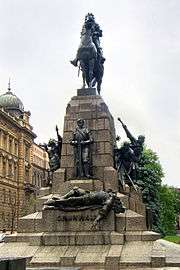Antoni Wiwulski


| Wikimedia Commons has media related to Antoni Wiwulski. |
Antoni Wiwulski or Antanas Vivulskis[1] (1877–1919) was a Polish[2]-Lithuanian[3][4][5] architect and sculptor.
Biography
He was born February 20, 1877 in Totma in Vologda Governorate in the Russian Empire, where his father, of Lithuanian (Samogitian)[6] origin, served as a forest superintendent.[4] He graduated from the reputable Jesuit boarding school Zakład Naukowo-Wychowawczy Ojców Jezuitów w Chyrowie and then two of the most prestigious art and architecture universities of the epoch: the École Supérieure des Beaux-Arts in Paris and the Higher Technical School in Vienna.
Among the most notable of his works are:
- the Battle of Grunwald monument in Kraków, Poland
- Chapel in Šiluva, Lithuania
- Three Crosses on the Hill of the Three Crosses Vilnius, Lithuania
- the Holy Heart of Jesus' Church in Vilnius, Lithuania
The latter building was started in 1913 and was the first example of usage of reinforced concrete in former Polish-Lithuanian Commonwealth. Wiwulski, astonished by the possibility to build gigantic buildings of the newly rediscovered material prepared a project of a giant church with a stylised gigantic sculpture of the Creator sitting on the dome. However, the project was discontinued after Wiwulski's death on January 10, 1919.
In 1919, despite suffering from tuberculosis, he volunteered for the Polish militia (Lithuanian and Belarusian Self-Defence) and took part in the defence of Vilnius against the Bolshevik assault in the early stages of atrocities during the Lithuanian–Soviet War and Polish-Bolshevik War compains. He contracted pneumonia while on guard in the Vilnius' suburb of Užupis.[7][8] After his death he was buried in the cellars beneath the church he had designed. When it was converted by the Soviets into a Palace of the Construction Workers in 1964 his ashes were moved to Rasos Cemetery.[9]
A monograph on Wiwulski was published by Nijolė Tolvaišienė in 2002[1]
References
- 1 2 Nijolė Lukšionytė-Tolvaišienė (2002). Antanas Vivulskis: Tradicijų ir modernumo dermė (Antanas Vivulskis (1877-1919): combination of traditions and modernity) (in Lithuanian). Academy of Fine Arts Press: Vilniaus dailės akademijos leidykla. p. 163. ISBN 9986-571-79-0.
- ↑ Phillips, Charles (1933). Paderewski - The Story of a Modern Immortal. The Macmillan Company. p. 280. ISBN 0-306-77534-4.
- ↑ Lithuania - Past & Present By E. J. Harrison - Page 190
- 1 2 Centropa: a journal of central European architecture and related arts, Volume 3 - Page 249
- ↑ History of the Literary Cultures of East-Central Europe: Junctures and Disjunctures in the 19th and 20th Centuries, by John Neubauer - Page 23
- ↑ O. Franciszek Świątek, "Jasny i mocny duch Antoni Wiwulski (1877-1939)", Wilno, 1939, s. 10
- ↑ Wiktor Zenonowicz (1986). "Rys życia autora wileńskich Trzech Krzyży (A sketch on the author of Three Crosses)". Nasza Gazeta (in Polish). 8 (547). Retrieved 2006-07-10.
- ↑ J. Polonus (July 2005). "Grunwaldzkie uroczystości (Anniversary of Grunwald)". Źródło (in Polish). 705 (27): 31–33. Retrieved 2006-07-10.
- ↑ Katarzyna Deptuła (April 2001). "Cmentarz na Rossie (Rasos Cemetery)". Gazeta Wyborcza (in Polish). Retrieved 2006-07-10.
